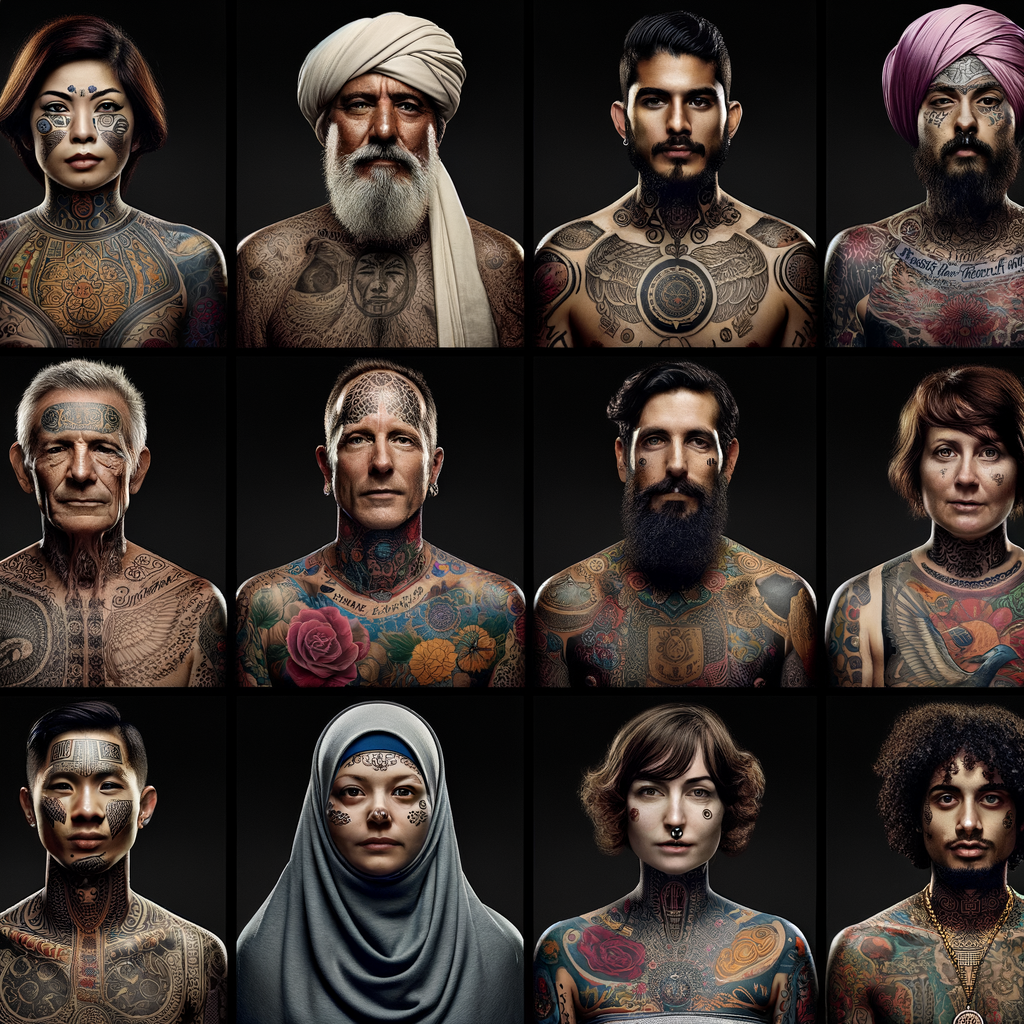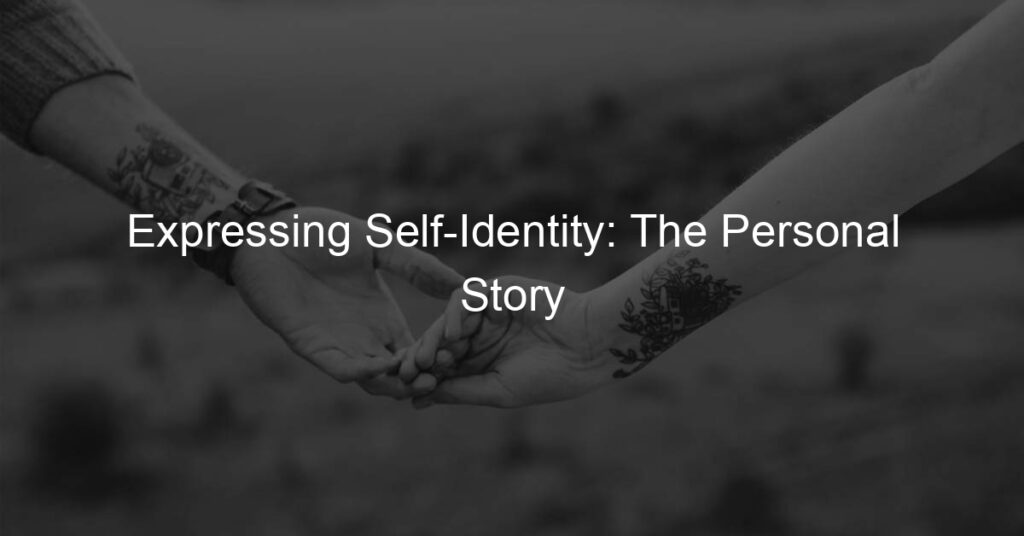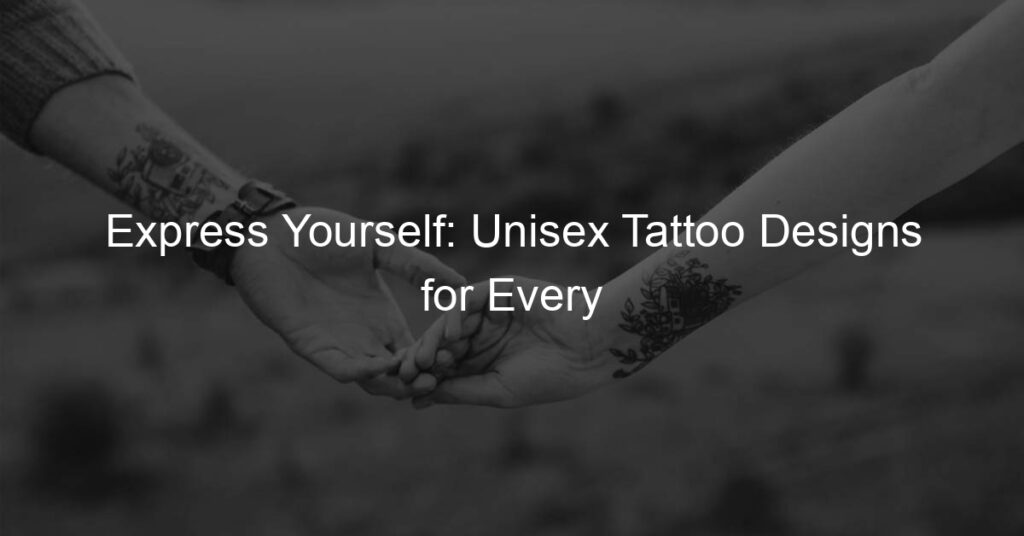
Introduction to Personal Identity Tattoos
When we think of tattoos, we often picture intricate designs inked on the skin. But tattoos are more than just body art. They are a form of personal expression, a way to tell a story, and a symbol of identity. In this article, we will delve into the concept of personal identity tattoos and explore how they have evolved over time.
- Understanding the Concept of Personal Identity Tattoos
- How Tattoos Have Evolved as a Form of Personal Expression
Tattoos have been used for thousands of years to signify a person’s identity. A personal identity tattoo is a unique design that represents the individual’s personality, beliefs, experiences, or values. It’s like a personal signature, but instead of being written on paper, it’s inked on the skin. For instance, a person might get a tattoo of a lion to show their courage, or a rose to symbolize love.
In the past, tattoos were often associated with certain groups or cultures. For example, sailors would get tattoos to mark their travels, and tribes would use tattoos to signify their status. But over time, tattoos have become a popular form of personal expression for people from all walks of life.
Today, people get tattoos for a variety of reasons. Some get tattoos to commemorate a loved one, to celebrate a milestone, or to express their creativity. Others get tattoos to make a statement, to stand out, or to show their commitment to a cause. The evolution of tattoos reflects our changing attitudes towards self-expression and individuality.
In the following sections, we will delve deeper into the history of tattoos, their significance, their symbolism, and their role in society. We will also explore the psychological aspects of tattoos and look at the future of this fascinating form of personal expression.
The Inked Identity: A Historical Perspective
Throughout the ages, tattoos have served as significant identity markers. Let’s delve into the fascinating history of tattoos and their role in personal identification.
- Tracing the history of tattoos as identity markers
Tattoos have been a part of human culture for thousands of years. The oldest known tattooed human skin to date is found on the body of Ötzi the Iceman, who lived around 5,300 years ago. These ancient tattoos were likely used for therapeutic or symbolic purposes.
As societies evolved, so did the use of tattoos. In many cultures, tattoos were used to signify status, religious beliefs, and even accomplishments. They became a way for individuals to express their identity and differentiate themselves from others.
In the Polynesian culture, for example, tattoos were a form of language. Each tattoo told a story about the person’s lineage, social status, and achievements. They were a visual representation of a person’s identity.
- Case study: Ancient tribal tattoos and their significance
Let’s take a closer look at the Maori people of New Zealand, known for their intricate facial tattoos called ‘Ta Moko’. These tattoos were more than just body art. They were a rite of passage that marked a person’s transition from childhood to adulthood.
Each Ta Moko was unique and contained information about the person’s genealogy, tribal affiliations, status, and achievements. They were a visual representation of a person’s identity and place within the society.
In conclusion, tattoos have a rich history as identity markers. From the ancient tribes to modern societies, they have served as a powerful tool for self-expression and personal identification. As we move forward, the significance of tattoos as identity markers continues to evolve, reflecting the changing dynamics of our society.
Tattoo Significance: More than Just Body Art
Tattoos are not just about aesthetics or following a trend. They often carry a deeper significance, serving as personal markers of significant life events or as symbols of personal beliefs and values. In this section, we will explore the meanings behind common tattoo designs and understand how tattoos serve as personal markers of significant life events.
- Exploring the Deeper Meanings Behind Common Tattoo Designs
Many popular tattoo designs carry profound meanings. For example, a rose tattoo often symbolizes love and beauty, while a lion represents courage and strength. Let’s delve deeper into some common tattoo designs and their associated meanings.
| Tattoo Design | Meaning |
|---|---|
| Rose | Love, Beauty |
| Lion | Courage, Strength |
| Butterfly | Transformation, Change |
| Anchor | Stability, Security |
Understanding the meaning behind these designs can help us appreciate the depth and complexity of tattoo art. However, the interpretation of a tattoo can vary from person to person, and a design that holds a specific meaning for one person may have a completely different significance for another.
- How Tattoos Serve as Personal Markers of Significant Life Events
Tattoos often serve as permanent reminders of significant life events. They can commemorate milestones like graduations, births, or personal achievements. They can also serve as tributes to loved ones or as symbols of overcoming adversity.
For instance, a person might get a tattoo of a graduation cap to commemorate their academic achievement. Another might get a tattoo of a loved one’s name or a symbol that represents them as a tribute. Some people get tattoos to mark their recovery from illness or addiction, using the tattoo as a symbol of their strength and resilience.
These tattoos serve as personal markers, helping individuals remember and celebrate important moments in their lives. They are more than just body art; they are visual narratives of personal journeys and experiences.
In conclusion, tattoos are a powerful form of self-expression. They can carry deep personal meanings, serve as markers of significant life events, and tell stories about the individual’s life and experiences. So, the next time you see a tattoo, remember that there’s likely a deeper story behind it.
Tattoos and Identity: A Sociological Perspective
When we talk about tattoos, we’re not just talking about ink on skin. We’re talking about personal expressions, stories, and identities. Let’s delve into the sociological perspective of tattoos and how they shape our identities.
- How societal perceptions of tattoos have changed over time
- Case study: Tattoos in the workplace and their impact on professional identity
In the past, tattoos were often associated with rebellion and deviance. However, societal perceptions have significantly changed over time. Today, tattoos are seen as a form of self-expression and individuality. They are no longer confined to certain groups or subcultures but have become mainstream.
According to a Pew Research Center study, nearly 40% of millennials have at least one tattoo. This shows how societal acceptance of tattoos has increased over the years. Tattoos have become a part of our culture, reflecting personal stories, beliefs, and values.
Let’s look at a case study that explores the impact of tattoos in the workplace. In the past, visible tattoos were often seen as unprofessional. However, this perception is gradually changing.
A study conducted by Andrew Timming at the University of St Andrews found that tattoos are no longer a kiss of death in employment. In fact, in some industries like fashion, advertising, and media, tattoos can be seen as a plus. They can help create an image of creativity and non-conformity, which can be beneficial in these industries.
However, the acceptance of tattoos in the workplace can vary depending on the industry, the nature of the job, and the type of tattoo. For instance, a small, tasteful tattoo might be more acceptable in a corporate setting than a large, visible one. This shows how tattoos can impact our professional identity and how we are perceived in the workplace.
In conclusion, tattoos are not just body art. They are a reflection of our identity, shaped by societal perceptions and our professional environment. As society continues to evolve, it will be interesting to see how the role of tattoos in identity formation will change.
Tattoo Symbolism: Decoding the Art
One of the most fascinating aspects of tattoos is the rich symbolism they carry. Each design tells a unique story, reflecting the individual’s personality, experiences, beliefs, or aspirations. In this section, we will delve into the world of tattoo symbolism and explore the meanings behind some of the most common tattoo designs.
Common Symbols in Tattoos
There are countless tattoo designs, each with its unique symbolism. However, some symbols are more popular than others. Let’s take a closer look at these common symbols and understand their meanings.
- Understanding the symbolism of popular tattoo designs
- Examples of personal stories behind common tattoo symbols
Some of the most popular tattoo designs include hearts, roses, butterflies, and tribal patterns. Hearts often symbolize love and passion, while roses can represent beauty, love, or even sorrow. Butterflies are typically associated with transformation and freedom, and tribal patterns often signify a connection to a specific culture or heritage.
Every tattoo tells a story. For instance, a person might choose a butterfly tattoo to symbolize their personal transformation or growth. A rose tattoo might be a tribute to a loved one or a symbol of overcoming a difficult experience. The meaning of a tattoo is deeply personal and can vary greatly from person to person.
Understanding the symbolism behind tattoos can provide a deeper appreciation for this form of self-expression. Whether it’s a simple heart or an intricate tribal pattern, each tattoo carries a message that is as unique as the individual who wears it.
Unique Tattoo Symbols and Their Meanings
While many people choose popular symbols for their tattoos, there are some who opt for less common symbols that hold a personal significance. These unique symbols often tell a story that is deeply personal and meaningful to the individual.
- Exploring less common tattoo symbols and their personal significance
- Case study: The role of unique tattoo symbols in identity expression
When it comes to tattoos, the possibilities are endless. From ancient symbols to modern art, people choose a wide range of unique symbols to express their personal stories, beliefs, and values. For instance, a person might choose a tattoo of a rare bird species to symbolize their love for nature and wildlife. Another person might opt for a geometric pattern that represents their fascination with mathematics or science.
These unique symbols are not just about aesthetics; they carry a deeper meaning for the wearer. They serve as a constant reminder of who they are, what they value, and what they aspire to be. In essence, these tattoos are a form of self-expression that goes beyond the surface.
Let’s take a look at a case study to better understand the role of unique tattoo symbols in identity expression. John, a 35-year-old artist, has a tattoo of a quill on his forearm. The quill is not a common tattoo symbol, but for John, it holds a significant meaning. It represents his passion for art and his commitment to his craft. Every time he looks at his tattoo, he is reminded of his journey as an artist and his dedication to continue creating.
This case study illustrates how unique tattoo symbols can serve as a powerful tool for identity expression. They allow individuals to visually communicate their personal stories, values, and beliefs in a way that words often cannot. In the end, the meaning of a tattoo is not determined by its popularity or commonness, but by the personal significance it holds for the wearer.
In conclusion, unique tattoo symbols offer a unique way for individuals to express their identity. They serve as a visual representation of the wearer’s personal story, values, and beliefs. So, the next time you see a tattoo, remember that there might be a deeper meaning behind it that goes beyond its aesthetic appeal.
Personal Expression through Tattoos: A Psychological Perspective
When we think about tattoos, we often consider their aesthetic appeal or the personal stories they tell. However, from a psychological perspective, tattoos can serve a much deeper purpose. They can be a form of self-therapy and a coping mechanism for trauma and loss. Let’s delve deeper into these aspects.
- How tattoos can serve as a form of self-therapy
Getting a tattoo is a personal decision that often involves a great deal of thought and reflection. For many, it’s a way to express feelings, experiences, or identities that might be difficult to put into words. In this sense, tattoos can serve as a form of self-therapy.
According to a study published in the American Journal of Psychiatry, tattoos can help individuals deal with emotional pain. By choosing a design that symbolizes their struggle, they can externalize their internal turmoil. This process can be therapeutic, helping individuals confront and manage their emotions.
- Case study: Tattoos as a coping mechanism for trauma and loss
Let’s look at a real-life example to understand how tattoos can serve as a coping mechanism for trauma and loss. Consider the story of Jane, a woman who lost her husband in a tragic accident. Jane decided to get a tattoo of a small bird, a symbol that reminded her of her late husband’s love for nature.
This tattoo served as a constant reminder of her husband, helping her cope with her loss. It also provided a way for her to keep her husband’s memory alive. Jane reported that the tattoo helped her in her healing process, making her feel closer to her husband even after his death.
In conclusion, tattoos can serve as a powerful tool for personal expression and psychological healing. They allow individuals to externalize their internal struggles, serving as a form of self-therapy. Moreover, they can act as a coping mechanism, helping individuals deal with trauma and loss.
While tattoos are often seen as mere body art, their psychological significance cannot be understated. They are a testament to the resilience of the human spirit, a symbol of personal strength and recovery.
| Key Takeaways |
|---|
| Tattoos can serve as a form of self-therapy, helping individuals externalize their internal struggles. |
| Tattoos can act as a coping mechanism for trauma and loss, serving as a constant reminder of loved ones or past experiences. |
| The psychological significance of tattoos is profound, symbolizing personal strength and recovery. |
Body Art Identity: The Role of Tattoo Artists
When we talk about tattoos, we often focus on the person wearing the ink. But what about the artists who create these permanent symbols of personal identity? They play a crucial role in shaping the body art identity of individuals. Let’s delve into their world and understand their contribution to this art form.
- Understanding the tattoo artist’s role in shaping body art identity
Tattoo artists are not just service providers; they are creators, consultants, and sometimes, therapists. They listen to the stories, ideas, and emotions of their clients and translate them into unique pieces of art. They guide their clients in choosing the right design, size, and location for their tattoos, ensuring that the final piece reflects the individual’s identity accurately.
A tattoo artist’s role goes beyond the technical aspects of inking. They help individuals express their personalities, beliefs, and experiences. They are the bridge between a person’s inner world and their physical representation.
- Case study: A day in the life of a tattoo artist
Let’s take a peek into the life of a tattoo artist to understand their role better. Meet Alex, a tattoo artist with ten years of experience. His day starts early, with him checking his schedule and preparing his tools. His first client arrives, a woman who wants a tattoo to commemorate her mother. Alex listens to her story, sketches a few designs, and they finally settle on one. He carefully inks the design on her arm, ensuring every detail is perfect. The woman leaves, satisfied with her new tattoo, a piece of her identity etched on her skin.
The rest of Alex’s day is filled with similar interactions. Each client comes with a story, an idea, or a memory they want to immortalize. Alex’s job is to bring these narratives to life through his art. His work is not just about creating beautiful designs; it’s about understanding people and helping them express their identity.
In conclusion, tattoo artists play a significant role in shaping body art identity. They are the unsung heroes of this art form, helping individuals express their stories, beliefs, and experiences in a unique and personal way.
| Role of Tattoo Artists |
|---|
| Creators of unique art pieces |
| Consultants for design, size, and location choices |
| Therapists who listen to clients’ stories and emotions |
| Translators of personal experiences into physical representations |
Meaning of Tattoos: Personal Narratives
As we delve deeper into the world of tattoos, we find that each tattoo carries a unique story. These personal narratives give us a glimpse into the significance of tattoos for different individuals. Let’s explore some of these stories and the key takeaways from them.
- Personal stories of individuals and their tattoos
- Key takeaways from personal tattoo narratives
Meet Sarah, a 35-year-old teacher who got her first tattoo at the age of 30. For Sarah, her tattoo of a sunflower represents her journey towards positivity and growth. She says, “Every time I look at my tattoo, I am reminded of my strength and resilience. It’s a symbol of my personal growth.”
Then there’s Mike, a 40-year-old firefighter, who has a dragon tattoo on his arm. Mike shares, “The dragon represents courage and strength. It’s a constant reminder of my commitment to protecting others.”
These narratives highlight the deeply personal and symbolic nature of tattoos. They are not just body art; they are a reflection of one’s identity, experiences, and values.
From these personal narratives, we can glean several key insights:
| Insight | Explanation |
|---|---|
| Tattoos are personal | Every tattoo has a unique story behind it, reflecting the individual’s personal journey. |
| Tattoos are symbolic | People often choose tattoo designs that represent certain values or experiences. |
| Tattoos are empowering | For many, tattoos serve as a reminder of their strength, resilience, and growth. |
These insights underscore the profound significance of tattoos. They are more than just body art; they are a form of self-expression and identity.
As we continue to explore the world of tattoos, we will discover more about their historical, sociological, and psychological aspects. Stay tuned for more insights into the fascinating world of body art and identity.
Identity Expression through Ink: The Future of Tattoos
In this final section, we will explore the potential future of tattoos as a form of identity expression. We will delve into the possible trends in tattoo design and symbolism, and discuss how societal acceptance of tattoos may evolve in the future.
- Predicting future trends in tattoo design and symbolism
As tattoos continue to grow in popularity, we can expect to see new trends emerge in design and symbolism. With advancements in technology, we may see more intricate designs and unique methods of tattooing. For instance, 3D tattoos and glow-in-the-dark inks are already gaining traction.
Symbolism in tattoos is also likely to evolve. As society changes, so do the symbols we use to represent ourselves. In the future, we may see more tattoos that represent personal beliefs, values, or experiences, rather than traditional symbols. For example, tattoos symbolizing mental health awareness or environmental consciousness are becoming more common.
- How societal acceptance of tattoos may evolve in the future
Societal acceptance of tattoos has come a long way. Once seen as a sign of rebellion or deviance, tattoos are now widely accepted and even celebrated as a form of personal expression. However, there is still some stigma attached to tattoos, particularly in certain professions or cultures.
In the future, we may see this stigma continue to decrease. As more people get tattoos and public perception continues to shift, tattoos may become even more normalized. In fact, a recent survey showed that 30% of Americans have at least one tattoo, up from just 20% a decade ago.
Furthermore, as tattoos become more common in the workplace, we may see more companies adopting tattoo-friendly policies. This could lead to a future where tattoos are not just accepted, but embraced as a form of personal identity expression.
In conclusion, the future of tattoos is bright. With evolving trends in design and symbolism and increasing societal acceptance, tattoos will continue to be a powerful tool for identity expression.
| Key Takeaways |
|---|
| Future trends in tattoo design and symbolism will likely reflect societal changes and advancements in technology. |
| Societal acceptance of tattoos is likely to increase, with more companies adopting tattoo-friendly policies. |






